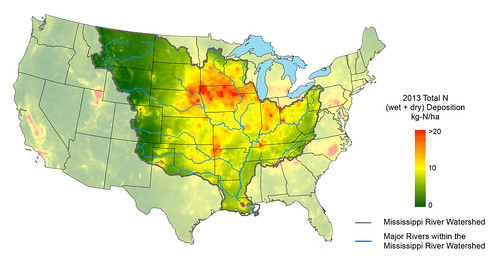
This post is part of the Science Tuesday feature series on the USDA blog. Check back each week as we showcase stories and news from USDA’s rich science and research portfolio.
It’s a case of “darned if you do, darned if don’t.”
The global population is projected to reach 9.7 billion by 2050 and we will have to grow a lot more food to feed all of those people. Some might think we would need to use a lot more fertilizer; however, too much fertilizer—nitrogen and phosphorus—can be disastrous to ecosystems, affecting the water, land, air, and biodiversity. The nutrient challenge is to improve fertilizer efficiency to produce more food and energy crops while creating less pollution.
Each year farmers apply millions of tons of manufactured fertilizer, of which 40-80 percent is lost to the environment. Unfortunately, fertilizer run-off that ends up in lakes, rivers, and estruaries can lead to eutrophication, which is harmful to the ecosystem. Eutrophication is a process where fertilizer stimulates dense marine and fresh water plant growth, which can lead to the death of animal life due to lack of oxygen. Eutrophication is responsible for the 2014 algae bloom in Lake Erie that poisoned drinking water in Toledo, Ohio.
At sea, eutrophication may lead to dead zones; there are nearly 500 eutrophic and hypoxic (low oxygen) zones around the world, including 12 in the Chesapeake Bay. Excess fertilizer also plays a role in acidification and is linked to unhealthy bleached coral.
NIFA is working to monitor and mitigate the effects of excess fertilizer and prevent its occurrence in the first place. One example is NIFA support of the National Atmospheric Deposition Program, which tracks how airborne nitrogen is deposited in the United States and contributes to the dead zone in the Gulf of Mexico. The agency provides $500,000 in Hatch Act funding for state agricultural experiment station research and coordinates $1.8 million per year of interagency funding in support of the program
NIFA has also provided millions of dollars from various grant programs to support fertilizer-related research, education and extension projects. These efforts include improving the efficiency of fertilizers, promoting more effective use of fertilizers, mitigating and reducing strategies, and developing precision technology.
The fertilizer industry has recognized the problem. The U.S. Fertilizer Institute and the International Plant Nutrition Institute promotes the use of the “4Rs” as a management practice for farmers. The 4Rs include: right source/kind (match the fertilizer type to crop needs); right time (make nutrients available when the crop needs them); right rate (match the amount of fertilizer to crop needs); and the right place (keep nutrients where crops can use them).
Nitrogen use efficiency is quantifiable; the more efficient the uptake of nitrogen by the plant, the less escapes into the environment. Existing and future NIFA-supported research, coupled with the application of the 4Rs, will help solve the nutrient challenge.
NIFA invests in and advances agricultural research, education and extension and seeks to make transformative discoveries that solve societal challenges.

